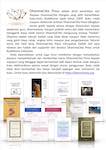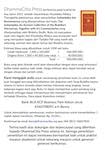Selamat datang di situs DhammaCitta!
Situs ini merupakan situs referensi Buddhisme yang dapat digunakan baik untuk pelajar maupun praktisi untuk mendapatkan rujukan dari teks-teks Buddhisme tertua maupun buku-buku kontemporer dan definisi dari istilah-istilah Buddhisme.
Selain itu, anda dapat berdiskusi di forum diskusi, mendownload/unduh berbagai buku elektronik di bagian download maupun membaca artikel yang ditulis oleh para kontributor.
Permintaan Buku Cetak
Untuk permintaan buku cetak, silahkan isi formulir ini
Penerbitan 2021/2
DhammaCitta Press akan menerbitkan Sutta Nipāta bersama komentarnya.
Penerbitan terlambat dan tidak sesuai target tahun 2021, masih dalam progres. Semoga dapat diselesaikan segera.
Mohon dukungannya 🙏🏼

